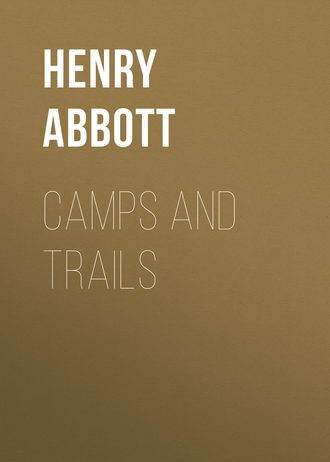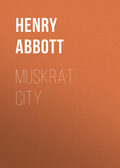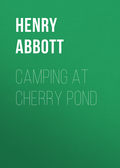
Abbott Henry
Camps and Trails
The following day, I went down to the lake and from the boat out in the middle of the lake I sighted across my compass over the shoulder of the mountain and determined that I should start from the shore of the lake, instead of the river, follow a course toward 280 degrees while the needle was at zero, till I reached the crest of the shoulder, and then swing toward 270 degrees. This proved to be the correct theory and in the course of time my three mile trail ended within ten rods of the cabin. This saved us a walk of two miles up the river bank and a boat ride of more than half a mile on the lake, besides cutting out a steep climb where the grade, in the opinion of one of our guests, was "ninety-five per cent."
This trail making incident occurred fourteen years ago. It serves to indicate how easy it is for one to go astray in a large forest. I have since blazed many trails in the woods. I have also, many times been misplaced in the forest while hunting or exploring and am always on such occasions reminded of Bige's advice to "never argue with your compass while in the woods." Whenever my compass tells me that camp is in a direction opposite to that which reason and memory and the lay of the land indicates, my practice is to sit down on a log, lay the compass on the log, stand the gun up against a tree far enough away so the steel of its barrel will not influence the compass needle and try to arrange in mind the topography of the country I am in. After a reasonable rest I am always willing to follow the pointing of the compass at least for a limited distance.
The first impulse of one who thinks he is lost in the forest is that of haste. One is always in a desperate hurry to get somewhere quick. If this impulse is obeyed and the now alarmed traveler rushes off at headlong speed, the danger is, not only that of going in the wrong direction, but in nine cases out of ten, the victim travels in circles. The psychology of deliberation is like first aid to the injured and the victim soon begins to realize that he is not really lost. He is only temporarily mislaid and will soon pull himself out and locate some familiar landmark.
The "Davy Crockett Camp" we built on a narrow shelf on a steep hillside. It overlooked "Muskrat City" which lay in the valley directly in front and below our open "lean-to." We were well pleased with the result of our efforts in the construction of this forest boarding house. It had a fireplace in front for heating the camp and a cooking fireplace at one side. This arrangement kept the cooking odors out of our camp blankets and clothing. We also had a dining table and a kitchen table, both made of split logs. The water was good and the entire outfit comfortable. Moreover, we generally had good luck in hunting while there.
The best way to reach Davy Crockett's was to go up the river about seven miles, then take the "Elk Pond Tote Road" back through the woods five miles to Muskrat City. We also sometimes used another route which was shorter but more difficult. This was by way of Dan'l Boone's; from which point we had cut a trail down the valley and over the western end of Crescent Mountain.
Several times I tried to get a photograph of the Crockett Camp. Because of its location I could get no standing room for a front view. If the camera was placed up the hill back of the camp the picture would show only the roof. One day I climbed a tree with the camera and took a snap shot at the side. The artist spoiled this film in developing. The following winter, six feet of snow broke down the roof and in a wind storm a large tree fell across it and smashed the shack. It was not rebuilt and I never got a picture of the Davy Crockett Camp.
We once set up a tent alongside the "Cherry Pond Camp" and for a week, entertained there a party of six hunters and four guides. It proved to be a strenuous business to provide enough food for ten husky appetites. However, they all expressed the wish that they might come again; we therefore, concluded that they were not sent away very hungry.
The "Cedar Lake Camp" on the shore of that lake, was in a good fishing region. It was a starting point as well, for exploring trips. Through the waters of that lake and its many tributary streams with short carrys to other lakes and ponds, we could make long excursions by boat.
The "Buck Mountain Camp" was at first a cabin similar to Danl's. Later we built an open camp addition which we used for sleeping quarters during the summer but we usually slept in the cabin in cold weather. A short distance from this camp was "The Anxious Seat" which has been fully described in another story.
One day while staying at this camp I was hunting in the valley north of Parker's Pond. Had just crossed a beaver meadow and entered a thicket of balsam and cedar trees, when I came upon the saddest and most distressing sight I have ever witnessed in the woods. Under the shelter of these evergreen trees in a space perhaps twenty yards in diameter, I counted the bleaching skeletons of seventeen deer. Eight of these were small, evidently the bones of young animals, less than a year old. The ground within this space was trampled hard and bare of green vegetation. Witch hopple bushes had been pulled up by the roots and the larger stems and branches stripped of twigs were left lying on the ground. Ground hemlock had been skinned of everything except the main stems. Even the bark was gone. The lower branches of the trees, balsam, cedar and a few hemlocks to a height of seven feet from the ground were stripped bare of twigs and bark. A fallen and rotting hardwood tree lay partly within the circle of death. Beyond the bone yard, this tree trunk was covered with a heavy coating of moss. Within, it had been scraped and gnawed. Starvation was written in large letters all over the place.
In summer time the deer find food in plenty everywhere; and in great variety. In winter their diet is more limited as to variety but they can always find enough food if they are able to move about. Deer can manage fairly well even in deep snows, so long as the snow remains soft. They also have been seen traveling on a hard crust formed on top of four or five feet of snow. But when the crust is thin and the deer breaks through, the thin sharp edges of icy crust cut his legs and a bloody trail marks the path of his floundering until, discouraged, he returns to the "yard" in the evergreen thicket, where he, and a number of his fellows herd together for protection from the cold winds of our northern winters. Within this yard the animals move about and pound down the falling snow, while outside, the drifts grow deeper. Here, when the crust had formed on the snow and every green thing within easy reach had been eaten, the deer stood upon his hind legs, stretching his long neck to its utmost length and reached into the lower branches of the overhanging trees for a mouthful of browse. When the last scrap of brush had been devoured, too weak to longer stand, he lay down to await a slow and lingering death by starvation. And when the last feeble blat of the last surviving member of the herd trembled on the frosty air, the curtain fell on the saddest of all woodland tragedies.
Every summer we find it necessary to cut out trees which have been thrown across our trails by storms of the previous winter. Sometimes, the limb of a tree falls through the roof of one of our camps, making repairs necessary. Occasionally, in our absence, a porcupine gnaws our rustic camp stools or eats up the dining table; now and then, some animal friend steals our food, but these are minor troubles that are easily cured or provided against.







